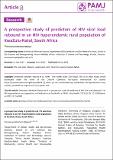| dc.description.abstract | Introduction: globally, up to one third of people living with HIV had unsuppressed viral loads in 2020, making it imperative to understand the various predictors of HIV viral load rebound (HVLR) in specific hyperendemic subpopulations. The objectives of this study were threesome: to determine the period prevalence of HIV viral load rebound in the study population; to describe the association between categorical predictor variables and the geometric mean population viral load (GMVL) and finally to quantify the role of each predictor in determining the hazards of HIV-viral load rebounds in this community.
Methods: data from a prospective cohort study from one of Africa´s largest population-based HIV surveillance in KwaZulu-Natal, South Africa was used to understand predictors of HVLR. Data from HIV-positive individuals who had viral load measurements as well as a suppressed VL followed by at least one viral load measurement between 2011-2018 was analyzed descriptively and inferentially using univariable and multivariable recurrent-events regressions to understand predictors of HVLR. Data management and analyses were done using the R-software and statistical significance was evaluated at the p-value of 0.05.
Results: from a total of 9467 individuals who had at least one viral load measurement, rebound events were observed in 1165 (12.3%) individuals, reflecting falling short of the last 95 of UNAIDS 95-95-95 strategy by 2030. Characteristics such as age, sex, education, marital status, place of residence and antiretroviral (ART) adherence were predictive of hazards of HVLR in both univariable and multivariable analyses. In a multivariable model, hazards of HVLR decreased with increasing age (p < 0.05), increased with being male by 41% (aHR: 1.406; 95% CI: 1.206, 1.639), decreased with having primary education by 22% (aHR: 0.777; 95% CI: 0.612, 0.986), increased with being single by 26% (aHR: 1.259; 95% CI: 1.064, 1.491), decreased by living in rural by 13% (aHR: 0.872; 95% CI: 0.767, 0.992) and decreased with ART adherence by 17% (aHR: 0.834; 95% CI: 0.744, 0.934).
Conclusion: in this setting, the prevalence of HVLR was high, at 12.3% reflecting falling short of the last 95 of UNAIDS 95-95-95 strategy and HVLR was independently associated with being younger, male, having no education, being single, living in rural areas and being ART-adherent. These predictors must be considered in HIV intervention packages to achieve the last 95 of the 95-95-95 HIV-AIDS strategy by 2030 in this setting. | en_US |

